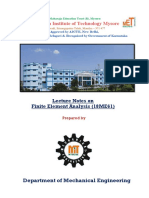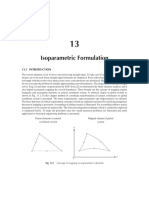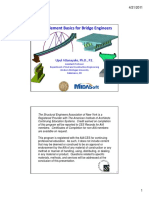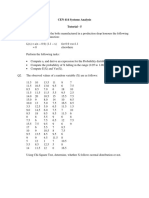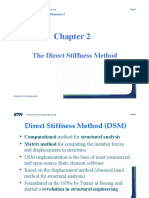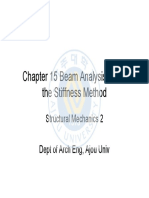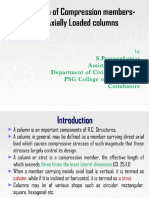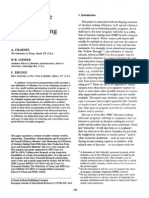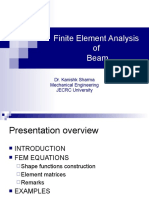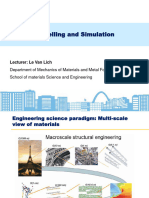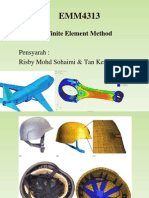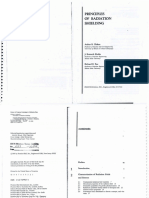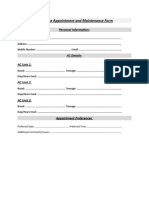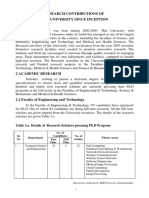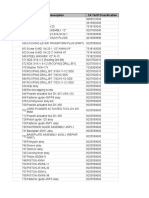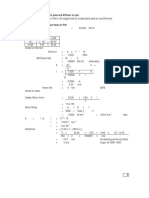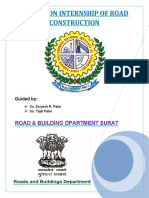3CL1201 Finite Element Method for Structural
Engineering
INTRODUCTION
OF
FINITE ELEMENT METHOD
Paresh V. Patel
Department of Civil Engineering
Institute of Technology, Nirma University, Ahmedabad
Calculation of Area or Perimeter of Circle
Inscribing
Circumscribing
1
�Area or Perimeter
Exact Solution
No. of Segments
2
�Idealization Process
3
� FEM/DSM Breakdown
FEM/DSM Assembly & Solution
4
� DEFINITION
The finite element method is a
numerical method for solving problems
of engineering and mathematical
physics.
Useful for problems with complicated
geometries, loadings, and material
properties where analytical solutions
can not be obtained.
BRIEF HISTORY
Hrennikoff [1941] - Lattice of 1D bars to
McHenry [1943] - Model 3D solids
Courant [1943] - Variational form
Levy [1947, 1953] - Flexibility & Stiffness
Argryis and Kelsey [1954] - Energy Principles for Matrix
Methods
Turner, Clough, Martin and Topp [1956] - 2D elements
Clough [1960] - Term “Finite Elements”
Zienkiewicz [1967] – First book on FEM
Grew out of aerospace industry.
Post-WW II jets, missiles, space flight
Need for light weight structures and accurate stress analysis
Paralleled growth of computers
5
� APPLICATIONS
Categories of problems :
Equilibrium Problems (Static)
Eigen Value Problems (Dynamic)
Propagation Problems (Transient)
Areas :
Structural/Stress Analysis
Soil Mechanics
Heat Transfer
Fluid Flow
Electro-Magnetic Fields
Acoustics
ADVANTAGES
Irregular Boundaries
General Loads
Different Materials
Boundary Conditions
Variable Element Size
Easy Modification
Dynamics
Nonlinear Problems (Geometric or
Material)
6
� STEPS IN PROCESS
Discretize and Select Element Type
Select a Displacement Function
Derive Element Stiffness Matrix & Load Vector
Assemble element matrices
Introduce B.C.’s
Solve for the primary unknowns i.e. Unknown
Degrees of Freedom
Solve for secondary unknowns i.e. Element
Stresses and Strains, Interpret the Results
ILLUSTRATIVE EXAMPLE
7
�1. Discretization, Select Element
2. Select Displacement Function
• Either trigonometrically or polynomial
function
• Depending on number of Nodal degrees of
freedom
• Based on Pascal’s triangle or tetrahedral
• Satisfy Convergence requirement
8
� 3. Calculate Element Properties
• Stiffness Matrix Where,
B = Strain – Displacement Matrix
[Ke] =
E = Strain – Stress Relation
• Load Vector Where,
N = Shape function – variation of
[Fe] = [N]T p dV quantity in element
V
p = Body force
4. Assembly of Element Matrices
Global stiffness matrix Global load vector
Ne Ne
[ K ] = [Ke] { F } = [Fe]
1 1
It is not simple summation but superimposition depending on DOF
Final equilibrium equations [K] {D} = {F}
5. Incorporate Boundary Conditions
Different methods:
Large diagonal method
Row – column delete
Re-arrangement of Rows and columns
9
�6. Solution of Primary Unknowns
Solve for displacements i.e.
{D} = [K]-1 {P}
Direct solution techniques:
Choleskey’s decomposition
Gauss elimination or Gauss Jordon Method
Gauss-Siedel method
Half band Gauss elimination
Skyline solution technique
Frontal technique
7. Solution of Secondary Unknowns
Calculation of internal forces and stresses from nodal
displacements
{} = [D] [B] {q}
COMMERCIAL PACKAGES
• ALGOR
• ANSYS
• COSMOS/M
• STARDYNE
• ABAQUS
• MSC/NASTRAN
• SAP2000
• ADINA
• NISA
• IDEAS
• PRO/E ……………………
10
�• Advantages of General Purpose Programs
– Easy input - preprocessor.
– Solves many types of problems
– Modular design - fluids, dynamics, heat, etc.
– Can run on PC’s
– Relatively low cost.
• Disadvantages of General Purpose Programs
– High development costs.
– Less efficient than smaller programs,
– Often proprietary. User access to code limited.
11
�12
�13
�14
�15
�16
�17
�18
�19
�20
�21
�22
�23
�24
�25
�26
�27
�28
�29
�30
�31
�The Building Structural System - Physical
Building Structure
Floor Diaphragm
Frame and Shear Walls
Lateral Load Resisting System Floor Slab System
Gravity Load Resisting System
Sub-structure and Member Design
Beams, Columns, Two-way Slabs, Flat Slabs, Pile caps
Shear Walls, Deep Beams, Isolated Footings, Combined Footings
ALTERNATIVES FOR MODELING
(a) Real Structure
(b) Solid Model (c) 3D Plate-Frame (d) 3D Fram e
(e) 2D Fram e
Fig. 1 Various Ways to Model a Real Struture
32
� TYPES OF ELEMENTS
• 1 D Elements (Beam type)
– Can be used in 1D, 2D and 2D
– 2-3 Nodes. A, I etc.
Truss and Beam Elements (1D,2D,3D)
• 2 D Elements (Plate type)
– Can be used in 2D and 3D Model
– 3-9 nodes. Thickness
Plane Stress, Plane Strain, Axisymmetric, Plate and Shell Elements (2D,3D)
• 3 D Elements (Brick type)
– Can be used in 3D Model
– 6-20 Nodes.
Brick Elements
DOF for 1D Elements
Dy Dy Dy
Rz Dz
Dx Dx
2D Truss 2D Beam 3D Truss
Ry
Dy Dy Dy
Rz
Dx Rz Rx Dz Dx Rx
Rz
2D Frame 2D Grid 3D Frame
33
�DOF for 2D Elements
Ry ?
Ry ?
Dy Dy
Dy
Rz Dz Dx Rx
Dx Rx
Rz
Plate Shell
Membrane
DOF for 3D Elements
Dy
Dz Dx
Solid/ Brick
34
�Slab T = 200 mm
Beam Width, B = 300 mm
Beam Depth, D
a) 300 mm
b) 500 mm
c) 1000 mm
Applications of FEM
Slab T = 200 mm
Beam Width, B = 300 mm
Beam Depth, D
a) 300 mm
b) 500 mm
c) 1000 mm
35
� Applications of FEM
Effect of Beam Size on
Moment Distribution
a) Beam Depth = 300 mm
c) Beam Depth = 1000 mm b) Beam Depth = 500 mm
• The Walls are part of the
frame and act together with
the frame members
• The lateral loads is
primarily resisted by the
shear in the walls, in turn
producing bending moment.
• Partial loads is resisted by
the frame members in
moment and shear
36
� • The lateral loads is primarily
resisted by the Axial Force in
the braces, columns and
beams in the braced zone.
• The frame away from the
braced zone does not have
significant moments
• Bracing does not have to be
provided in every bay, but
should be provided in every
story
Full 3D Finite Element Model
37
�2D Finite Element Model – Gear
2D Finite Element Model – Gear
38



